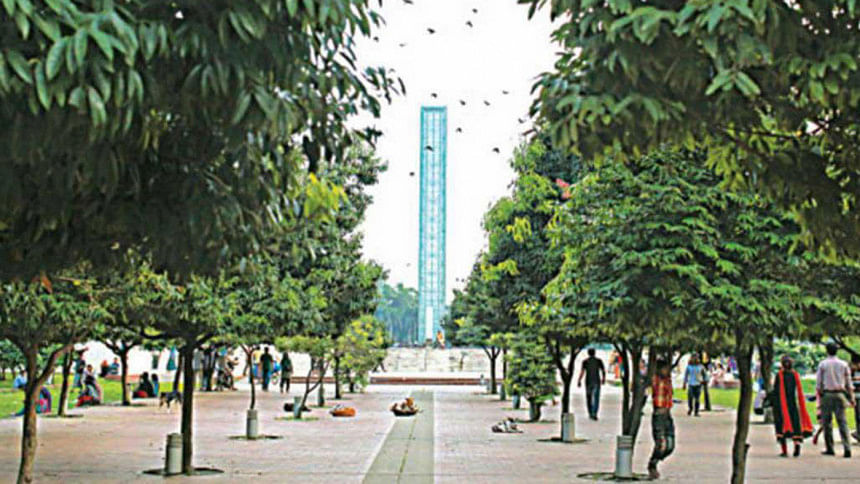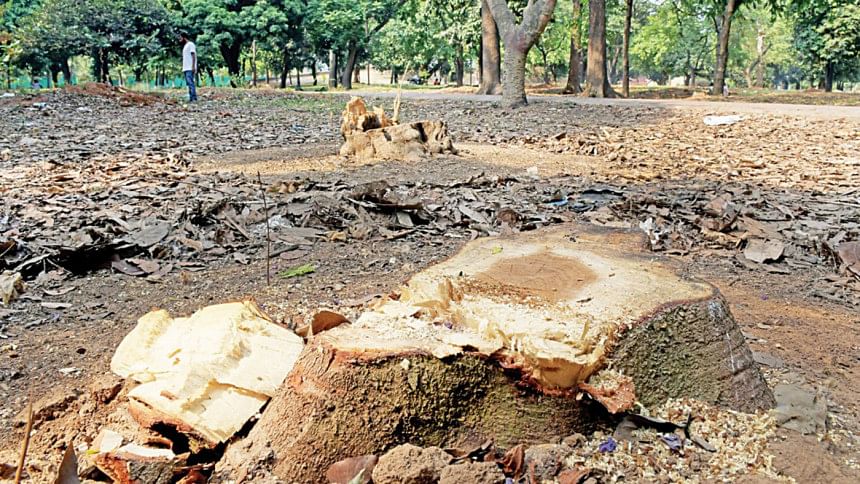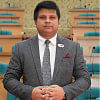Felling trees at Suhrawardy: Another ‘justified’ case of violation of environmental law?

Reportedly, a good number of trees including medicinal plants has been cut down as part of a project 'to enhance the beauty and greenery' of Suhrawardy Udyan by the Public Works Department. The beautification project includes construction of restaurants and concrete walkways in a place that embodies our dreams, memories, and reflections- a place where Bangabandhu's historic and immortal 7th March speech was delivered.
The project raises few serious questions: Whether building structures at the cost of environmental destruction is at all justified? Whether this project involving the felling of trees at a place which is also considered as the lung of Dhaka city is at all necessary? Whether this beautification project involves any environmental impact assessment? Whether this project considers the aesthetic, cultural, and historic value of the place? Whether this project in any way considers the fact that this place is also the habitat of diverse plants and animals?
These questions, among others, need to be taken into account in order to assess the compatibility of this development project with the principles of environmental justice. Despite not being an environmental scientist, I can state, and not exaggerate that the project fails to recognise the ecological significance of the trees while causing serious damage to the biodiversity of the locality.

The project apparently indicates that environmental impact assessment (EIA) has not been properly undertaken. EIA could unveil, in no uncertain terms, the potential impacts of the project on environment. Moreover, the EIA could also underscore the aesthetic, socio-economic, cultural, and other positive as well as negative impacts of the project while underlining the mitigation plans to offset the negative impacts. It is noted that the undertaking of EIA being part of Environmental Clearance Certificate is a pre-condition for undertaking any development project under the Bangladesh Environment Conservation Act 1995. It is quite frustrating to see that the provision of EIA is often used to 'justify' development projects rather than to ensure sustainability of the projects.
The beautification project at Suhrawardy Udyan violates the Mega city, Divisional Town and District Town's Municipal Areas including Country's all the Municipal Areas' Playground, Open space, Park and Natural Water Reservoir Conservation Act, 2000 as well. Section 5 of the Act prohibits the changing of nature or class of such places which are marked as playfield, open space, park and natural water bodies and such places cannot be used, rented, leased or transferred for any purposes other than what they originally are meant for.
The explanation to section 5 states that the act of felling trees that destroys the fundamental feature of a park shall be considered as an act 'changing nature or class of a park'. It is noted that such act of changing the nature or class of a park is a punishable offence under the Act for which the wrongdoer may face imprisonment of five years or fifty thousand taka as fine or may be penalised with both. Section 8 of the Act also stipulates that the building structure or any other infrastructure built in violation of the provisions of this Act will be confiscated as per the directions of the Court.
It is noted that the aforesaid development project not only disregards the provisions of the Act of 2000 but also manifests yet another case of 'justified' violation environmental law while allowing the cutting down of trees in the name of greenery and beautification. The project also contradicts with the provisions related bio-diversity stipulated in the Constitution of Bangladesh and other implementing laws.
Such an unmindful development work purported to be undertaken at Suhrawardy Udyan also goes against several directions and important observations handed down by the High Court Division while disposing of a Writ Petition that sought the preservation of the said Udyan. Ramna or Suhrawardy Udyan, as per the Court, is not just an area. "….the area is the centre of all democratic freedom movements in Bangladesh. In that context, the entire area demands to be preserved as a special zone. There should not be any establishment that can pale the history and heritage of the area," the HCD sensitively observed.
While Dhaka is being considered as one of the worst livable cities in the world, such indiscriminate felling of trees in the name of development project will add more to make the city unhabitable for us, the human beings and even for the plants as well as the animals. It is quite alarming to note a usually forgotten yet true fact that such inhumane activities by human beings against nature will not only lead to the destructions of our habitats but also jeopardise our very existence.
The ongoing Covid-19 pandemic reminds us again about the intricate relationship between human health and the health of our planet signifying that saving nature is essentially about saving ourselves. The pandemic unveils the underlying significance of biocentric or eco-centric perception of environment while disregarding anthropocentrism, perpetuating human dominance over nature. The aforesaid development project is being undertaken while a nationwide lockdown is being enforced- all happening at a time when we should have rethought the human-nature relationship, to correct wrongs against nature while restoring the value of nature. We have probably missed yet another opportunity to unlearn the language of dominance and exploitation and re-learn the intrinsic value of nature.
Let me conclude with reference to a letter by Chief Seattle which reads as follows:
'Every part of the Earth is sacred to my people. Every shining pine needle, every sandy shore, every mist in the dark woods, every clear and humming insect is holy in the memory and experience of my people. The sap which courses through the trees carries the memory and experience of my people.'
How could we forget the memory, experience and ecological essence of historic Suhrawardy Udyan?
The writer teaches Environmental Law at the University of Dhaka.

 For all latest news, follow The Daily Star's Google News channel.
For all latest news, follow The Daily Star's Google News channel. 



Comments